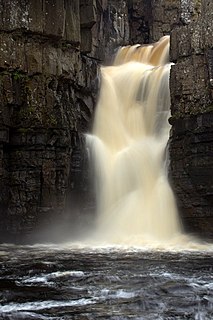
The River Tees is a river in northern England. It rises on the eastern slope of Cross Fell in the North Pennines, and flows eastwards for 85 miles (137 km) to reach the North Sea between Hartlepool and Redcar near Middlesbrough. The modern day history of the river has been tied with the industries on Teesside in its lower reaches, where it has provided the means of import and export of goods to and from the north east region. The need for water further downstream also meant that reservoirs were built in the extreme upper reaches, such as Cow Green.

Kielder Water is a large man-made reservoir in Northumberland in North East England. It is the largest artificial lake in the United Kingdom by capacity of water and it is surrounded by Kielder Forest, one of the biggest man-made woodlands in Europe. The scheme was planned in the late 1960s to satisfy an expected rise in demand for water to support a booming UK industrial economy.

Grassington is a market town and civil parish in the Craven district of North Yorkshire, England. The population at the 2011 Census was 1,126. Historically part of the West Riding of Yorkshire, the town is situated in Wharfedale, about 8 miles (10 km) north-west from Bolton Abbey, and is surrounded by limestone scenery. Nearby villages include Linton, Threshfield, Hebden, Conistone and Kilnsey.
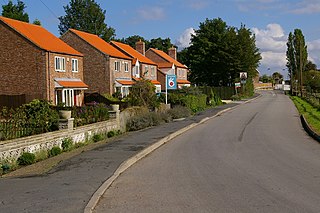
Wressle is a village and civil parish in the East Riding of Yorkshire, England, lying on the eastern bank of the River Derwent approximately 3 miles (5 km) north-west of Howden.

Barden is a civil parish in the Craven district of North Yorkshire, England. It consists of the hamlet of Drebley and a few scattered houses in Wharfedale in the Yorkshire Dales. The parish also includes two areas of moorland, Barden Fell to the east of the River Wharfe and Barden Moor to the west of the river. Both moorlands are access land, and are popular with walkers. Barden Fell rises to the prominent peak of Simon's Seat, and Barden Moor includes two scenic 19th century reservoirs. Much of the parish is on the Bolton Abbey estate.

Conistone is a small village in the Craven district of North Yorkshire, England. It lies 3 miles (5 km) north of Grassington, 3 miles (5 km) south of Kettlewell and 12 miles (19 km) north of Skipton beside the River Wharfe, in Upper Wharfedale.
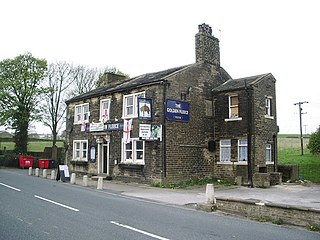
Ogden in West Yorkshire, England, is a small hamlet 5.0 miles (8 km) north of Halifax. The hamlet falls within the Calderdale Ward of Illingworth and Mixenden. Its most recognisable landmarks are Ovenden Moor wind farm, which can be seen from as far as 35 miles (56 km) away on a clear day, a golf course, which offers views of the surrounding moorland; and Ogden reservoir, around which are footpaths for visitors to walk and view the local wildlife.
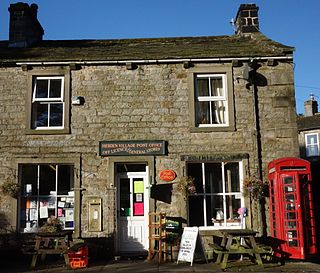
Hebden is a village and civil parish in the Craven district of North Yorkshire, England, and one of four villages in the ecclesiastical parish of Linton. It lies near Grimwith Reservoir and Grassington, in Wharfedale in the Yorkshire Dales National Park. In 2011 it had a population of 246.

The River Washburn is a river in Yorkshire, England. It originates high in the Yorkshire Dales and ends where it meets the River Wharfe. It lies within the Nidderdale Area of Outstanding Natural Beauty.

Spaldington is a village and civil parish in the East Riding of Yorkshire, England, lying approximately 3 miles (5 km) north from the market town of Howden and 14 miles (23 km) south of York. It lies to the west of the A614 road.

Greater Gabbard is a 504 MW wind farm on sandbanks 23 kilometres (14 mi) off the coast of Suffolk in England at a cost of £1.5 billion. Onshore construction activities commenced in early July 2008 at Sizewell. It was completed on 7 September 2012 with all of the Siemens SWT3.6–107 turbines connected.
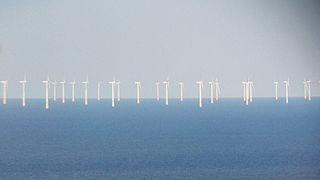
Gwynt y Môr is a 576-megawatt (MW) offshore wind farm located off the coast of North Wales and is the fifth largest operating offshore windfarm in the world. The farm has 160 wind turbines of 150 metres (490 ft) tip height above mean sea level.

Keadby Power Station is a 734 MWe gas-fired power station near Scunthorpe in North Lincolnshire. It lies near the B1392 and the River Trent, and the Scunthorpe-Grimsby railway. Also nearby is the Stainforth and Keadby Canal, which is part of the Sheffield and South Yorkshire Navigation.
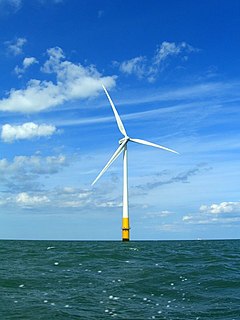
The Kentish Flats Offshore Wind Farm is a wind farm located off the coast of Kent, England on a large, flat and shallow plateau just outside the main Thames shipping lanes. The wind farm is operated by Vattenfall.
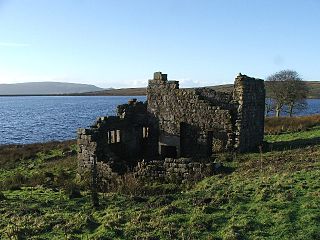
Grimwith Reservoir is located in the Yorkshire Dales in North Yorkshire, England. It was originally built by the Bradford Corporation as one of eleven reservoirs in the Yorkshire Dales to supply fresh water to Bradford. It is the largest reservoir owned by Yorkshire Water in terms of water storage.

The Lynn and Inner Dowsing wind farms are a pair of round 1 wind farms located in the North Sea, in the shallow waters at the entrance to The Wash off the coast of Lincolnshire, England. The wind farms were developed as a single unit after planning consent was given in 2003. Construction work began in 2006 and was completed in 2009.

Offshore wind power or offshore wind energy is the use of wind farms constructed in bodies of water, usually in the ocean, to harvest wind energy to generate electricity. Higher wind speeds are available offshore compared to on land, so offshore wind power’s electricity generation is higher per amount of capacity installed, and NIMBY opposition to construction is usually much weaker.

Pickering Beck is a river that runs for over 18 miles (29 km) from its source in the North York Moors National Park through the town of Pickering and on to its confluence with Costa Beck at Kirby Misperton. It is a meandering river that is fed by numerous named and unnamed becks and streams which flow over sandstone and limestone beds and an alluvia of sand, clay silt and gravel. The beck is known for flooding and in recent times has been a beneficiary of funding and experimental flood protection schemes.

Ovenden Moor Wind Farm is a wind powered electricity generating site in England. Ovenden Moor is located north of Halifax and west of Bradford in West Yorkshire. The site was opened in 1993 with 23 turbines, but these were later removed in favour of larger turbines but with 14 fewer towers. This updated the output of the site from 9.2 MWh to 22.5 MWh with an expected generation lifetime of 25 years. As the turbines can be seen from some distance and the fact that they overlook the Brontë Country to the north, they have the subject of continued criticism and objections.

Fraisthorpe Wind Farm is a wind power generating site located in the village of Fraisthorpe in the East Riding of Yorkshire, England. The site is just 2 miles (3.2 km) south of Bridlington and 40 miles (64 km) east of York. It was granted full planning permission in early 2015 when the Ministry of Defence dropped their objection to the site. This was despite the apparent vocal opposition by local people and councillors. It started generating electricity in August 2016.






















